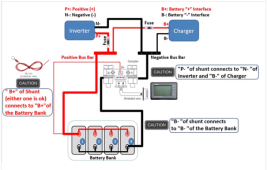Putting this out there for you guys to make up yr own mind
But I recently purchased a Renogy 500a smart shunt and was pre looking at installing it.
I was shocked to see such close proximity of the positive wire !!!!
There is only a small terminal connector holding in this positive cable and the proximity to the negative is scary
I will definitely be putting a cable retainer AND silicone at the terminal
I KNOW the shunt needs this positive feed to work but I feel there has been little consideration to keeping it apart from the negative if there was a accident
But I recently purchased a Renogy 500a smart shunt and was pre looking at installing it.
I was shocked to see such close proximity of the positive wire !!!!
There is only a small terminal connector holding in this positive cable and the proximity to the negative is scary
I will definitely be putting a cable retainer AND silicone at the terminal
I KNOW the shunt needs this positive feed to work but I feel there has been little consideration to keeping it apart from the negative if there was a accident





